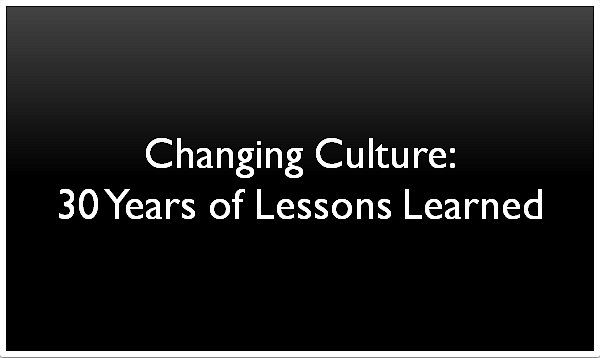
The Leader’s Role In Shaping Culture: A Theoretical Perspective
“Management controls, arranges, does things right; leadership unleashes energy, sets the vision so we do the right thing.” (Bennis & Nanus, 1985) [ii]
Much of present day thinking on the subject of leadership can be traced back to significant global economic changes that occurred in the early 1970’s and extended through the 1980’s following an extended period of post-World War II stability [iii]. At the time, “factors such as rapid technological change, heightened levels of competition, a rising flow of products from newly industrialized countries, volatility in OPEC (Organization of Petroleum Exporting Countries) pricing strategies, and changing demographic structures created a turbulent, unstable and competitive environment in which significant organizational change was imperative” [iv]. These events resulted in extensive employee downsizing and restructuring efforts that raised serious questions about the nature of the employee-organization relationship. In the past, there had been a tacit agreement that employee loyalty would be rewarded by long-term employment however this was no longer the case. The result was a disengaged workforce right at the time when organizations needed to reinvent themselves while at the same time achieving higher levels of productivity and performance [v].
This convergence of events focused attention on senior managers who were expected to successfully lead their organizations into the future [vi]. The problem was that the style of leadership that worked when things were stable and predictable wasn’t doing the job in this time of significant upheaval. This then was the catalyst for the surge in writing about leadership that occurred during this period. During this time, there emerged several influential leadership models that continue to be popular today. One of the most influential is transformational leadership which is based on the work of James McGregor Burns [vii] , a researcher and U.S. Presidential biographer.
Transformational (and Transactional) Leadership
“Transformational leadership should be encouraged, for it can make a big difference in the firm’s performance at all levels” (Bass, 1990: 25).
Burns studied the histories of various political leaders and augmented this with his own observations to identify patterns of leadership characteristics. From this work he differentiated between two distinctly different leadership styles. The first was the ordinary or transactional leader who exchanged tangible rewards for the work and loyalty of followers. The second was the extraordinary or transformational leader who focused on higher order intrinsic rewards by engaging followers to seek out new ways of working that would be beneficial for both parties [viii]. This was further developed by Bernard Bass, a distinguished professor of organizational behavior in the United States, who evolved it into a model that remains influential to this day. Most notably Bass argued that effective leaders have characteristics of both leadership styles however a transformational style is significantly more effective than transactional leadership in stimulating the discretionary effort of employees and achieving higher levels of performance [ix]. It is also the style that is best suited for dealing with rapidly changing environments in comparison to transactional leadership which is effective during times of stability [x].
If we take a closer look at the characteristics of transformational and transactional leadership styles, it is easy to see their influence on current thinking. A transformational leader is described by Bass and others [xi] as inspirational and charismatic providing followers with intellectual stimulation and personal attention. By comparison, transactional leaders contract with followers to provide rewards and recognition in exchange for effort, performance and achievements [xii]. General Electric’s Jack Welch, Sam Walton at Wal-Mart, C.R. Smith at American Airlines, Michael Dell of Dell Computers, and William Hewlett and David Packard at Hewlett-Packard are just a few of the names held up as role models of transformational leadership at the time [xiii]. Even today, highly successful leaders such as General Norman Schwarzkopf who led the U.S. Military during the Gulf War, Steve Jobs who guided the resurgence of Apple, Lou Gerstner Jr. who successfully resurrected IBM, and inspirational founder-leaders such as Tony Hseih at Zappos.com and Larry Page at Google are described in the media and books in transformational terms; leaders who inspire and draw out the best from others.
There is a clear message that successful leaders are those that model themselves after these transformational leaders. Furthermore, the fact that popular role models are typically high-profile executives sends a strong message that it is senior management’s responsibility to create the culture their organization need to achieve their current and future goals and aspirations. It is therefore perhaps not surprising that people at all levels look to senior managers for this type of leadership [xiv].
While highly influential on thinking and approaches to leadership, one of the main criticisms of transformational leadership as it was originally defined is that it failed to acknowledge the difference between ethical and unethical behavior [xv]. For example, inspirational and charismatic leadership had been attributed to a number of senior leaders that later were linked to scandals and even a few have been found guilty of criminal actions. Kenneth Lay and Jeffrey Skilling of Enron, Bernard Ebbers of WorldCom, L. Dennis Kozlowski of Tyco Corp. and Tony Hayward of British Petroleum are just a few high-profile examples. This is at least partly responsible for an increase in attention to alternative views of leadership such as the servant leader also known as stewardship and Level 5 leadership [xvi].
Servant Leadership
“The great leader is seen as servant first, and that simple fact is the key to his greatness” (Greenleaf, 1997: 21).
Servant leadership was introduced by Robert Greenleaf (1904-1990), a management researcher who spent most of his career at AT&T. In 1977, he wrote the book Servant Leadership which is around the same time as James McGregor Burns introduced transformational leadership [xvii]. However, unlike transformational leadership, his perspective on leadership failed to grab the attention of managers and practitioners until fairly recently.
Servant leadership provides a perspective that is in stark contrast to the image of the all powerful, charismatic leader (think of Jack Welch) with the servant leader essentially a humble steward of their organization’s human, financial and physical resources [xviii]. He or she is typically depicted as self-effacing putting the needs of the organization, his or her colleagues, and the people he or she serves above his or her own interests. The names of the individuals cited as examples of servant leadership are predictably less well known than their charismatic counterparts. This includes highly successful CEOs such as Darwin-Smith at Kimberly-Clark and Colman Mockler of Gillette [xix].
The main difference between the servant leader and the transformational leader can arguably be found in the use of power. While the latter typically approaches leadership from a top-down and hierarchical point of view, servant leaders operate from a position of collaboration, trust, and empathy. At the core, the individual is a servant first, making the conscious decision to lead in order to better serve others, not to increase their own power. The objective is to enhance the growth of individuals in the organization and increase teamwork and personal involvement [xx]. In effect, the senior leader or leaders are responsible for creating a culture where these values are fostered and lived on a daily basis.
In this respect, current interpretations of servant leadership share with transformational leadership the belief that culture is the responsibility of senior managers who define the framework the organization needs and take steps to make this a reality. There is however an important difference which is illustrated by Jim Collins in his book Good to Great. Using an example of an airline pilot, he illustrates how leaders “manage the system, not the people” to create a culture that marries freedom and responsibility [xxi]. In other words, they create the conditions where people can apply their skills and knowledge to make decisions and act with confidence in the best interest of the organization and its stakeholders. Although they are actively involved in making this happen, they do it by working collaboratively with others as they search for ways to make things better for the organization, their followers and other stakeholders [xxii].
It is important to note that the above description is somewhat different from Greenleaf’s original account of servant leadership. In particular, Greenleaf believed that leadership is earned and leaders are chosen by followers who respond to them “because they are proven and trusted servants” [xxiii]. In this sense, leadership can be bestowed by followers on anyone at any level in the organization and is not a product of position or formal status. This is different from the view of Collins and others who suggest that leaders choose to lead in order to serve. Interestingly, it is also one of the constructs of relational leadership.
Relational Leadership
“…leadership shifts dynamically from one person to another, much as in guerrilla warfare, thus spelling the end of static, role-based leadership” McCrimmon (2010: 1).
The basic tenet of relational leadership is that leadership emerges out of the relationships between people working together to achieve order or change [xxiv] . As such, it is the outcome of a social influence process and is not attributed to a person’s position. To be specific, relational leadership “does not define leadership as holding a managerial position, nor does it use the terms manager and leader interchangeably. It sees leadership as able to occur in any direction; in some variations, it may result in the breakdown of the distinction between who is leading and who is following, instead reflecting a mutual influence process” [xxv] . It does not see leadership in terms of leaders and followers or managers and subordinates [xxvi] but rather as an emergent process involving participants [xxvii] , collaborators [xxviii] or partners [xxix] . These participants “are not passive recipients in need of direction and emotional support, but, rather, they are active agents who influence and are influenced by others” [xxx].
Relational leadership is emerging as an alternative to popular person-centric models such as transformational leadership which are seen to be not well suited to the complex, interconnected global society within which organizations operate today [xxxi]. The older traditional models are based on the presumption of predictability and the ability to plan and control change primarily by modifying the behaviors of leaders [xxxii]. This misplaced over reliance on individual leaders fails to recognize the unpredictability inherent in the relationships that exist between people, organizations and the dynamic environments that are the norm today. To be effective in these conditions requires the presumption of unpredictability which requires organizations and their members to act quickly, change directions agilely and deal effectively with ambiguity. This requires collaboration, diversity of perspectives, resilience, and the ability to deal with complexity that transcends individual positions and roles [xxxiii]. As such, leadership can be viewed as a ‘process’ that is closely tied to context and the specific needs of a particular situation, problem or challenge.
This is a dramatically different perspective that requires a significant shift in the way we think about leadership and how it plays out in organizations. In particular, it directly challenges the belief that senior managers by nature of the power vested in them via their positions can plan and control everything people do. Rather, they must be willing to let go of control and allow others to lead in order for the organization to thrive, grow and succeed.
Implications for Shaping and Changing Culture
What have we learned from this comparison of different perspectives on leadership? After all, senior managers are responsible for defining and setting the direction of the organization and providing inspirational leadership to its members. Hence, it is logical to assume that they are also responsible for deciding what culture the organization needs and then making it a reality. The fact is that senior managers do not, or at least should not, act in isolation of the rest of the organization. While their roles are more strategic than those of middle and first level managers, effective strategies including defining the culture the organization needs for the future is the product of ‘distributed leadership’ [xxxiv].
Second, making the desired culture a reality requires, like any other goal, the direct involvement of middle and first level managers as well as front line employees. This goes beyond merely following the lead provided by senior managers who are ideally modeling the behaviors defined by values they are articulating – aka ‘walking the talk’. It includes the design of the day-to-day practices and other artifacts of everyday organizational life that are within the scope of every manager at every level.
Third, it requires a systemic view of the organization including the design of its infrastructure which is in large part the responsibility of middle managers; the processes, systems, spaces, structures and so on that influence the way that things get done.
Fourth, most organizations have many cultures or subcultures which include at a minimum those defined by different occupations and functions (think of IT or Finance) and by different levels such as executives, middle and first-level managers. These subcultures often extend outside the organization walls into larger, often virtual communities such as that of the professional engineer, accountant and even CEO [xxxv]. While senior managers often are members of several subcultures, they rarely represent or understand the full range that exists, nor how they are contributing to current and future performance [xxxvi].
In other words, to effectively shape and change culture, managers at all levels need to think differently about their roles, how they influence culture, and what they can do to make the desired culture a reality. This includes thinking systemically about the organization and its environment to understand the other factors that are participating in the dynamics of culture.
Dr. Nancie Evans
Dr. Nancie Evans is co-founder and VP Client Solutions at Culture-Strategy Fit Inc. specializing in the alignment of organizational culture and strategy. She has developed a unique set of leading-edge diagnostic tools and approaches that provide leaders with deep insights into the culture of their organizations, how it is supporting or getting in the way of strategy execution, as well as the levers that they can use to drive rapid culture change.
CULTURESTRATEGYFIT®
Culture-Strategy Fit Inc. is a leading culture and executive leadership consulting firm conducting ground breaking work in leveraging culture to drive strategy and performance. It’s suite of culture surveys and culture alignment tools are used by market leading organizations around the world.
Contact Us
1.800.976.1660
nancie@culturestrategyfit.com
[i] <a href=” https://www.redbubble.com/people/rvalluzzi/works/31264389-spheres-of-influence-ink-on-paper “>Image created by Regina Valluzi </a>
[ii] Bennis, W. & Nanus, B. (1985). Leaders: The strategies for taking charge. New York: Harper & Row.
[iii] Hay, I. (2010). Transformational leadership: Criticisms and characteristics. Retrieved December 29, 2010 from http://www.leadingtoday.org/weleadinlearning/transformationalleadership.htm.
[iv] Ibid: p. 1.
[v] Conger, J.A. (1999). Charismatic and transformational leadership in organizations: An insider’s perspective on these developing streams of research. The Leadership Quarterly , 10 (2), 145-169.
[vi] Griffin, D.E.S. (2003). Transformational leadership. Retrieved December 29, 2010 from www.spiritualityand leadership .com/Transformational%20 Leadership %20 Griffin .doc
[vii] Burns, J.M. (1978). Leadership. New York, NY: Harper and Row
[viii] Hay (2010); Griffin (2003)
[ix] Bass and Avolio (1989) designed the Multifactor Leadership Questionnaire (MLQ) to measure the extent that managers demonstrate characteristics of transactional and transformational leadership. They have linked the survey results to external measures of employee effort and firm performance suggesting that transformational leadership is more effective than transactional in achieving both outcomes. For more information, see Bernard M. Bass and Bruce J. Avolio’s “Implications of Transactional and Transformational Leadership for Individual, Team and Organizational Development” in Research in Organizational Change and
Development, edited by Richard W. Woodman and William A. Pasmore (JAI Press, 1989).
[x] Bass (1985)
[xi] See for example Noel Tichy and Michelle Devanna’s Transformational Leadership (Wiley, 1986); Warren G. Bennis and B. Nanus’s Leaders: The Strategies for Taking Charge (Harper & Row, 1985); and Jan M. Kouzes and Barry Z. Posner’s The Leadership Challenge: Haw to Get Extraordinary Things Done in Organizations (Jossey-
Bass, 1987).
[xii] Bass (1990)
[xiii] Tichy & Devanna (1986); Kotter & Heskett (1992); Bass & Riggio (2006)
[xiv] Bass (1985) noted that transformational leadership can be displayed by anyone who formally or informally has people reporting to them however this message is diluted by the role models provided in the popular literature, as well as some of his writing which originally focused on leadership at the executive level.
[xv] Bass later modified his explanation of transformational leadership to differentiate between the authentic and pseudo-transformational leader to address criticism that the transformational leader can be unethical. The authentic transformational leader shares many of the qualities of the servant leader in that he or she is genuinely concerned about the needs of others and the organization as a whole. Similar to the servant leader, he or she is committed to serving a higher purpose and focuses his or her efforts on the greater good (Bass & Steidlmeier, 1999).
[xvi] Collins (2001)
[xvii] Greenleaf (1977)
[xviii] Collins (2001); Greenleaf (1977); Block (1987); Trevor M. Hall, ed. Becoming Authentic: The Search for Wholeness and Calling as a Servant Leader (2007) ISBN 978-1-929569-36-6 ; Robert Greenleaf. Servant Leadership ISBN 0-8091-0554-3 ; Peter Block. Stewardship ISBN 1-881052-86-9 ; Michael Parsons & David J. Cohen, eds. On Eagles’ Wings. An Exploration of Strength in the Midst of Weakness (2008) ISBN 978-0-7188-9195-4 ; James Autry. The Servant Leader ISBN 1-400054-73-7 ; Larry Spears, ed. Reflections on Leadership ISBN 0-471-03686-2 ; Larry Spears, ed. Insights on Leadership ISBN 0-471-17634-6 ; Larry Spears, ed. Focus on Leadership ISBN 0-471-41162-0 ; Larry Spears & Michele Lawrence, ed. Practicing Servant-Leadership ISBN 0-7879-7455-2 ; James Hunter. the Servant ISBN 0-761513-69-8 ; James Hunter. The World’s Most Powerful Leadership Principle ISBN 1-578569-75-3 ; John J. Sullivan, Servant First! Leadership for the New Millennium ISBN 1-594672-27-X ; Kent Halstead, Servant Leadership for Congregations; Max DePree, “Leadership is an Art” ISBN 0-440-50324-8 ; Dr. Kent M. Keith. “The Case For Servant Leadership”; James W. Sipe & Don M. Frick. Seven Pillars of Servant Leadership ISBN 978-0-8091-4560-7 ; Ken Blanchard, Leading at a Higher Level (Chapter 12), ISBN 0-13-234772-5 ; Denny Gunderson, The Leadership Paradox: A Challenge to Servant Leadership in a Power-Hungry World ISBN 978-1-57658-379-1 ; Jerry Glashagel, Servant-Institutions in Business, ISBN 978-0-9822-0123-7 ; Ken Jennings and John Stahl-Wert, The Serving Leader, ISBN 1-57675-265-8 ; Jim Boyd, A Servant Leader’s Journey, ISBN 978-0-8091-4568-3
[xix] Collins, J. (2001). Good to Great. New York, NY: HarperCollins.
[xx] Sipe, J.W. & Frick, D.M. (2009). Seven Pillars of Servant Leadership.
[xxi] Collins (2001: 124-125)
[xxii] Greenleaf (1977)
[xxiii] Greenleaf (1977: 24)
[xxiv] Uhl-Bien (2006)
[xxv] Ulh-Bien (2006: 667)
[xxvi] Rost (1995)
[xxvii] Hosking (1988)
[xxviii] Rost (1995)
[xxix] Graen & Uhl-Bien (1995); Uhl-Bien (2006)
[xxx] Osborne (2008: 1014)
[xxxi] Johnson (2007)
[xxxii] Osborne (2008)
[xxxiii] Johnson (2007)
[xxxiv] Mintzberg, H. (2009). We’re overled and undermanaged. Business Week. New York: Aug 17, 2009. p. 68
[xxxv] Schein, E.H. (1996). Three Cultures of Management: The Key to Organizational Learning. Sloan Management Review, 38 (1), 9-20.
[xxxvi] Boisnier & Chatman (2002)
The post The Leader’s Role In Shaping Culture: A Theoretical Perspective appeared first on Culture Strategy Fit.











